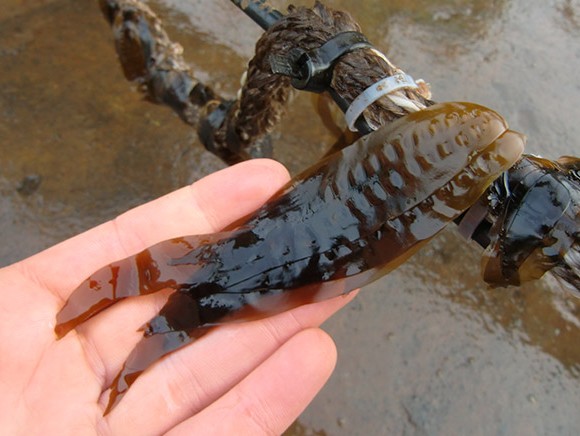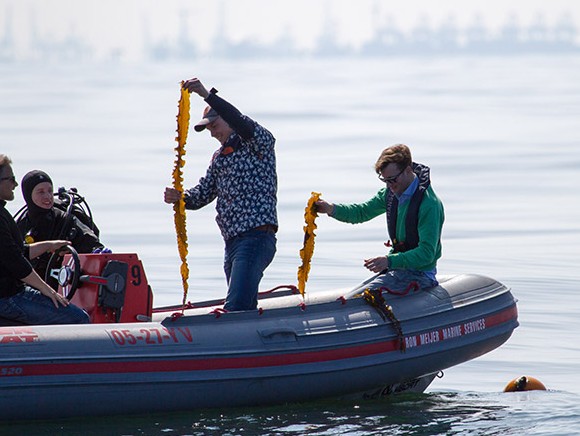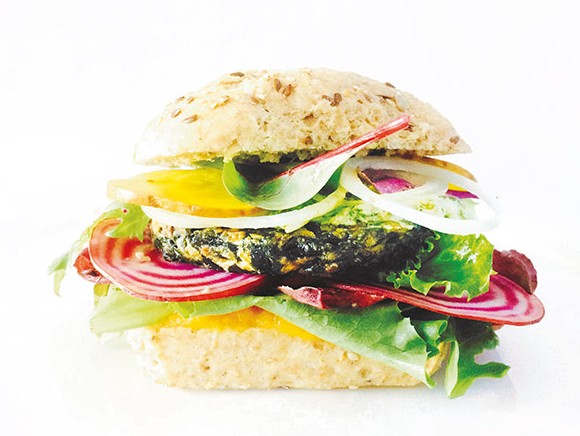
A pasta base, a seasoning in butter, or a jelly for desserts: the possibilities for seaweed extend far beyond just sushi. Its nutritional value also makes the crop a suitable meat substitute. But how easy is it to process seaweed? Is it even a safe food?
“Potentially enormous food source” demands thorough research and good marketing
A few black and yellow buoys and lines of small yellow buoys is all you see. Nothing would let on that here beneath the North Sea, 15 kilometres from the coast of Scheveningen, lies the source of what will be called “the food of the future”. Below the surface, seaweed is grown along two ropes that are each a kilometre long. The crop is being proposed as a solution to the recurring puzzle in the global food industry: how are we going to feed nine billion mouths in 2050? Seaweed is nutritious, versatile and sustainable to cultivate. Scheveningen is the site of one of the two Stichting Noordzeeboerderij (North Sea Farm Foundation) test farms, an NGO that is attempting to develop a strong and sustainable seaweed sector in the Netherlands.
Koen van Swam of the Stichting Noordzeeboerderij tells us: “We are the initiators of the Seaweed Platform, which was created to share knowledge and stimulate new projects. We are also the only European party facilitating offshore test forms, where we conduct research with WUR into the ecology, food safety and optimal conditions for cultivation. The seaweeds at the test farm are made available to the members of the Seaweed Platform. Van Swam: “There are now over 70 parties from industries such as food, feed and processing as well as from research institutions like the TNO.” The research is supported with money from ProSeaweed, a social innovation project in which the government and the business community collaborate with the goal of encouraging sustainable cultivation and making seaweed suitable as a plant-based source of protein for human and animal consumption. Large-scale seaweed cultivation is not yet cost effective in Western Europe: the project has to bring about change there. That requires multi-functional seaweed farms in the North Sea with a chain for logistics, processing and sale to the food industry.
What has suddenly made seaweed, which has been eaten for centuries in countries like Ireland, such a valuable, promising crop? “There are several reasons,” says Siebren van Tuinen, who is also involved in the research on the test farm from the WUR end. “The growing demand for safe and healthy food is challenging us to explore new food production methods. Seaweed can be grown without using freshwater, manure or land. It relieves a lot of the pressure on the agricultural system.” Koen van Swam adds: “Seaweed farms are doing exceptional work together with existing functions on the North Sea, such as coastal management, fishing and natural conservation. We want to start a seaweed cultivation pilot soon around the wind power generation parks in the North Sea. It will be a multi-use space and the infrastructure and security have already been organised. This allows us to lighten the load on the use of space at sea.” Beyond the advantageous sustainability aspects, seaweed is also highly suitable as food for humans. According to the Voedingscentrum (Food Centre), seaweed contains proteins and iron and is a source of minerals such as calcium, phosphorus, magnesium, sodium, potassium, iodine, and vitamin B. These are properties that make the crop a popular meat substitute.
That information has not gone unnoticed at Olijck sea vegetables, where various seaweed products have been developed in recent years. Remko Hol van Olijck: “We are sausage makers by trade. We ended up turning to seaweed because we needed to feed our pigs a protein-rich, healthy diet. We also began experimenting with products for people.”

His colleague Thijs Hoogveld adds: “That process took two years and is actually still under way. Seaweed has a unique character that we had to become acquainted with. Since then, we have been making burgers, soup and pasta with the crop. Because of its short shelf life when wet, we currently only use dried seaweed. Remko Hol has noticed that the demand for products with seaweed has sharply increased recently. “We have only been on the market for a year and our products are already being purchased by wholesalers, retailers and restaurants. Our products are currently still vegetarian, but we plan on serving the rapidly growing vegan market soon, too.” Thijs Hoogveld tells us that the possibilities are endless: “There are many different species and flavours. Butter, fried bacon and the sweet taste of shellfish: you can taste them all in seaweed.” However, the gentlemen tell us that the positive points that have been mentioned are still not a guarantee that consumers will buy. Remko Hol: “The story behind why we should be eating more seaweed makes sense, but it also needs to be enjoyable and delicious. It is still an unknown product for many consumers and that creates some hurdles. For this reason, our products are recognisable, accessible in terms of taste, and easy to prepare.”
Olijck is also aware that marketing is essential. Remko Hol: “We offered the exact same burgers under two different names: the seaweed burger and the sea vegetable burger. The second was received more positively.” Recent research by WER (Wageningen Economic Research) underscores the importance of communication with regard to positioning seaweed products. Research shows that seaweed in a product leads to a higher intent to purchase. It also turns out that the emotional messages that emphasise the sustainability aspect had a positive effect on the assessment of the product.

Another important aspect that comes into play when bringing seaweed products onto the market is food safety. Siebren van Tuinen, an expertise group leader at RIKILT, a research institute at WUR, conducts research into contaminants (substances that are potentially hazardous to one’s health). “Seaweed contains iodine and arsenic, which can be hazardous to your health if ingested in large quantities. However, the products that are currently available are entirely safe as long as you are not eating large quantities every day.” According to Van Tuinen, there is still a wealth of things to learn about seaweed: “It is a complex plant and we have only been engaged in research for a relatively short time. We know that there are enormous variations in terms of contaminants, which depend on things like the type of seaweed, the depth at which it is cultivated, the water temperature, and the time of harvest. The quantities of arsenic and iodine can even vary so much that if harvested at a certain time, the seaweed may contain questionable levels, while those levels may be much lower just a few weeks later. Van Tuinen feels that more research is required to achieve a flourishing sector in the Netherlands: “Seaweed is potentially an enormous food source and fortunately, we are seeing it on the shelves more and more often. However, within the EU, only about 15 of the roughly 20,000 species are registered for legal cultivation and implementation. How do you get water and undesirable “by-catches” out of seaweed effectively? How can it be efficiently, affordably and safely produced in the North Sea? Those are the things that we are in the process of discovering. European legislation requires that food producers register substances such as potential contaminants in a specific way. With our research, we will get a better hold on the process and we can consult businesses who want to start working with seaweed.” Koen van Swam tells us that businesses are lining up to do it, too: “We currently receive a request from an interested party every week.”
www.noordzeeboerderij.nl
www.olijckzeegroenten.nl
www.wur.nl
Source: Beeld zeewier en boot: ©STICHTING NOORDZEEBOERDERIJ, Beeld burger: ©OLIJCK